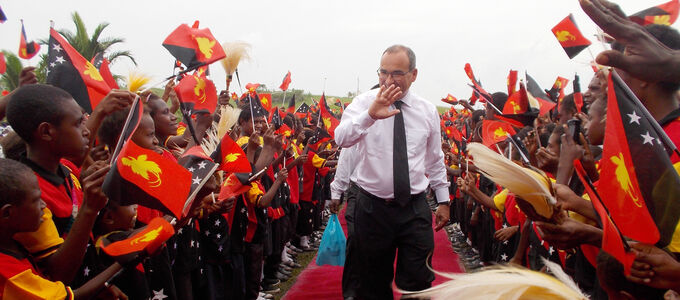
A 34-year-old man from Bosnia speaks 73 languages, a language service agency claims. But even with such an amazing talent one could not communicate with all the people in Papua New Guinea. Chief Apostle Jean-Luc Schneider decided to opt for the language of the heart.
A record 839 languages are spoken in Papua New Guinea. Depending on the source, this makes 12 per cent of the world’s living languages. Chief Apostle Jean-Luc Schneider will conduct two divine services in this multilingual country on 6 and 8 May. He arrived on the continent, Oceania, already last Thursday. This past Saturday he conducted a divine service for ministers and their wives and a service on Sunday, 1 May, for the members in Sydney, Australia. In this divine service, the retired District Apostle Andrew Andersen and his wife received a blessing on their golden wedding.
Language diversity
The island country of Papua New Guinea in the Pacific belongs to the Australian continent. It comprises the eastern half of the island of New Guinea and its offshore islands in Melanesia. The country gained its political independence from Australia in 1973. Many of the more than eight million people are descended from the original Papuan and Melanesian ethnic groups. They settled there about 60,000 years ago when the island was still connected by land to Australia. Melting glaciers caused the water level to rise at the end of the last ice age and the land bridge was submerged, separated the islands from the Australian mainland.
From then on, many tribes lived in isolated local societies, some more in the mountains and others mainly along the coast. This led to the development of innumerable languages.
Around 1526 the first Europeans sighted New Guinea. Nearly three hundred years later, colonial powers—Netherlands, Germany, and Great Britain—divided the political responsibility over what is now Papua New Guinea between themselves. As a result, further languages came to the region, some of which continued to develop. The official languages are Tok Pisin, English, and Hiri Motu, and Papua New Guinean Sign Language. The Chief Apostle will serve in English.
The rectangle in the rainforest
The last time Chief Apostle Schneider visited Papua New Guinea was in 2017, and he will likely never forget the approach to Kombikum. It looked like someone had carved a huge white and bluish rectangle into the middle of the rainforest. It turned out these were the brothers and sisters who had come from afar to see the Chief Apostle. Some had come on foot and had been on the road for up to seven days to participate in the divine service.
In order to provide for everyone, the congregations in the area had begun preparations months in advance: the brothers and sisters had grown extra food and built shelters. A total of 24,000 people attended the service.
Mainly Christian
The New Apostolic Church in Papua New Guinea was established about 44 years ago and has around 121,000 members. The membership here is bigger than in neighbouring Australia. And this despite the fact that Australia has almost three times the population of Papua New Guinea. The majority of people in both countries are Christian, but in Papua New Guinea more than 90 per cent describe themselves as Christians. Since its establishment, the New Apostolic Church in Papua New Guinea has been part of the District Apostle Area Western Pacific, which is led by District Apostle Peter Schulte.
On 6 May, Chief Apostle Jean-Luc Schneider will conduct a divine service in Kombikum, and on 8 May he will be in Madang for another one.
Photo: NAC Australia




